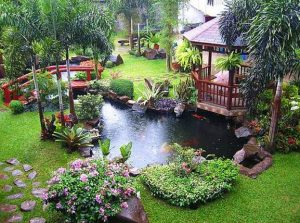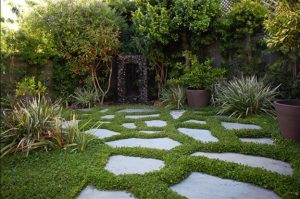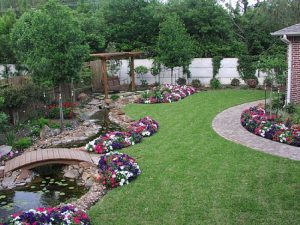The garden planning process starts with an analysis of the existing situation. You have to be aware, what are the values and what are the disadvantages of your garden. At first estimate the good views in the garden – to a natural territory, to a hill or a lake – mark on a plan all views, that you consider valuable. Mark also important views – from the garden terrace, from the living room in the house or any other place, which is used often. Estimate also bad views, which should be screened in the garden rearrangement process.
Every garden benefits from good garden design planning. Whatever your expectations are, planning and design are essential. One of the first questions I ask a client – as a garden design consultant – is “What do you want most from your garden?” The planning will focus on these needs and create a personalized garden that can be enjoyed by everyone for years to come.
One thing I have learned over the past twenty plus years as a garden design consultant is that very few people are totally content with their gardens. Despite the immense pleasure we derive from them, there is always something that could be better and this is where we, designers come in.
What Are The Essential Elements in a Good Garden Design Planning Strategy?
After the analysis is completed, the planning stage starts, during which it is important to take into consideration the five most important planning aspects.
- The First Aspect is Functionality. The garden plan should be created according to the functional zones of the territory. So, the first task is to divide the garden into functional zones.
Each garden has a representative zone. Usually it embraces the front yard and it is situated by the main entrance, where are the first views towards the property, when approaching it. The representative zone has a decorative meaning – it should be appealing during the whole year. Therefore, often evergreen plants are used in the representative area, plants, which have a beautiful silhouette, decorative leaves as well as annual flowers in the summer. Special decorative objects of art are also suggested to be placed in the representative zone of the garden.
The recreational zone is a garden area, which is used most often in the warm season. There can be a garden terrace or a gazebo as well as a bigger lawn area for outdoor activities and recreational equipment. If there is a swimming pool intended, it will also be placed in the recreational area. The recreational area can be divided into a quiet and active zone. The quiet zone is designed for relaxation, dining and resting, but the active zone can be designed for different sports activities – it can also include some sports fields. In the recreational area such plants are planned, which have a long flowering period and which are especially decorative in the warm season. Near the terrace or gazebo some scented plants can be projected.
Gardening is essentially about growing plants, but the setting in which we place them is probably the single most important element that makes a garden appealing or otherwise. Personal tastes in garden styles vary as much as in other aspects of living, and what appeals to one person may not appeal to another. The true test of good garden design is whether the result appeals to you. As a garden design consultant, I have always seen my role as a facilitator, aiming to assist my clients to create a garden design planning that reflects their taste and personality.
If children use the garden, a children’s playground will be one of the functional zones of the garden. The playground should be placed in such a part of a garden, which can be supervised by adults from a place, where they spend most of their time. It should be a sunny place, but shade also should be available in the hot season. The children’s playground is often dividend for children up to 6 years and for children 7 – 14 years of age. There are different activities and different types of play equipment intended for these age groups. The playground can have a special theme or it can be intended for some specific activities – imagination games, adventure, gymnastics, water therapy etc. Choose the plants by the playground carefully – be sure to avoid poisonous plants and plants with thorns.
Another important functional zone is the household area. It is a place, where you will put a compost heap, a barn or a greenhouse, where a dog can be kept and some construction materials can be stored. There was a tradition to screen the household area from the rest of the garden before, but nowadays it is often left open and designed so, that it looks appealing.
All elements, which are planned later in the garden should be arranged according to the layout of the functional zones. Do not mix elements from one zone into another one – that is the basic tip to form a logical garden layout.
- The Ecological Aspect. The ecological aspect suggests appreciating the natural values of the garden, to choose plants according to the ecological conditions of each specific place and to arrange the garden in an environmentally friendly way. Evaluate carefully the natural values of your site – do not rush to cut trees, shrubs and eliminate natural biotopes. A natural meadow, a wetland, a river coast or a forest ground cover can be much more valuable than artificially created plantings.
And moreover, when planning new plants, they should be chosen according to the ecological conditions of the place – sun or shade, humidity, nutrients in the soil, alkaline or acid soil etc. Plants with opposite ecological demands cannot be planted close together.
Ecology is the relationships between organism and their environment. Installing solar fountains is a perfect way to create an ecological garden decor.
Solar Fountains minimize carbon emission:
Since it is powered by the sun, there is no need of electricity supply from the grid. The generation of energy that we use indoor and outdoor produces greenhouse gases. Can you imagine how we can help minimize the harmful emission if all water fountains in the world use solar energy?
Solar Fountains conserve the natural environment:
Adding a solar fountain in your yard can serve as birdbaths. Clean and splashing water attracts birds. Birds are always an integral part of a natural environment. Birds visiting your yard will be more often making it their natural habitat.
Solar Fountains Are Good for the environment:
Using these types of fountains do not add pollution into the atmosphere. One of the environmental factors that cause diseases and health problems is air pollution, wherein different pollutants are present in the air that we breathe in.
- The Visual Aspect. This means the artistic composition of the garden – how will it actually look like? The garden composition like any kind of art has to be harmonic, based on a good choice of proportions. There can be different design concepts, but it is important to connect the concept with the existing situation – the landscape embracing the territory and the style of the buildings in the territory – all these elements should compose a united composition with the garden.
Order is created through symmetry through the technique of repeating plants or colors. Bold or bright additions bring balance as well as adding some texture. Texture is a very important ingredient. Gardens come to life with different textures or as the French say “Viva la difference.” The contrast of adjacent textures can be very exciting.
The garden style can be more natural – appropriate for countryside, bigger gardens and more natural environments. Or on the other hand it can be more artificial, composed of different pavements, architectural elements and regular forms – appropriate for city gardens, historical gardens and small sites. In countryside gardens the territory is often dividend in different zones of naturalness – closer to the house the garden is designed more regular and further away it becomes more natural.
- Psychological Aspect. It is important, that people in the garden feel comfortable, relaxed and are not restricted or stressed by anything in the garden. There are different environmental factors, which have impact on our perception of the garden (e.g. vastness, complexity, mystery, flexibility, uniqueness, light, colors, contrast, materials etc.) and they should be adjusted to the optimal level of the garden users, when creating a garden design. The optimal level is not the same for everybody – each person has a different optimal level for each environmental factor.
As a garden design consultant, what does the phrase, “a sense of belong” mean to you? We thought of the following meanings, but you may have thought of others:
- a clear sense of identity – even personality
- a sense of belonging – whether within the landscape or in harmony with the house
- a feeling of cohesion and completeness
Timelessness – garden design, like any other area of design, goes through fashions and trends, but the strongest gardens are often timeless. Designers may adopt contemporary ideas and incorporate them into an existing garden, but this will probably not change the ‘sense of place’ greatly; instead it should enhance it.
We experience a garden through every one of our senses, and a true sense of place is created when there is harmony between the different sensory messages we are picking up – touch, smell, sound, vision and even taste. For this reason, when creating a garden, you need to be aware of the different ways in which your design harnesses the senses.
- Economical. Get your garden or interior project online – professional, fast, cheap and it’s without leaving your home!
How often have you flipped through home and garden magazines, staring at the lovely well landscaped gardens thinking how costly it must be to get these gardens set up and maintain?
Can I Create An Exceptional Garden Design Planning on A Budget?
On the contrary, with a little bit of creativity and imagination, you can actually achieve the same artistic lawn in an economical way, by following some of these tips:
Look around your neighborhood and study which plants really grow well in your area. You can start gathering pictures from magazines or internet websites to get an idea of the garden design that you would want to have.
- What Color Suits You Best.
Once you had already chosen the plants that you want to see in your garden, you can now decide the color scheme for your garden design. Remember that you need to consider other factors such as the amount of sunlight that the plants you chose should get – should they get partial shade, full shade or partial sun, full sun? You can begin by building your foundation made of shrubs and choosing perennials, ornamental grasses, bulbs and annuals to give a wide selection of colors through the year.
- Take Into Account Your Budget.
You can turn your garden design into a long-term project, if you are short on cash. You can start with a foundation first and then add flowers or plants gradually. It is a good idea to start purchasing expensive plants first and make them the focal point of your garden design.
Watch out for garden sales and discounts at garden stores and nurseries. Perhaps you can trade plants with your friends, or you can let your friends know that you are starting a garden, and maybe they can share some of their plants or seeds with you. You can even do some seed swapping with other gardeners or maybe approach your local garden club for some seed samples that you can start to plant.
Try to make friends with your neighbors who have some fine gardens themselves and ask for some tips. You’ll never know, they may even give you some seeds to get you started.
- Draw a Rough Draft of Your Garden on Paper so You Get an Idea How Your Garden Will Look Like.
You can arrange the plants according to color or height. You should aim for harmony in color and variety in texture to make your garden interesting. To make it even more interesting, you can add some stepping stones, terra cotta bird houses, wind chimes and other simple accessories that you may already find around your garden such as old wooden chairs and ladders. All these elements layout in a way that you can truly identify who you are is what makes an exceptional garden design planning work specifically for your needs.
All it takes is a little imagination, time and patience and you’ll be on the road to creating a perfect garden design that is well within your budget.
 Keeping a garden designer is beneficial in a sense of saving both time and money. It reduces efforts and woes at your part as well. The things you want to look in a garden designer are experience, work abilities and his knowledge towards all sorts of flowers and plants. He or she should pay attention to what your needs and desires are. A garden designer should be a better listener for that cause. He or she should carefully jot down what your hopes and expectations are. After hearing to what you wish, a garden designer should advice what things are positive and what is impossible to carry out.
Keeping a garden designer is beneficial in a sense of saving both time and money. It reduces efforts and woes at your part as well. The things you want to look in a garden designer are experience, work abilities and his knowledge towards all sorts of flowers and plants. He or she should pay attention to what your needs and desires are. A garden designer should be a better listener for that cause. He or she should carefully jot down what your hopes and expectations are. After hearing to what you wish, a garden designer should advice what things are positive and what is impossible to carry out.

 You can choose from different themes like, modern, classic, chic, or whatever suits your personality. There are different materials from stores that could fit your theme, for sure. As mentioned, time and interest is needed in designing your patio garden. If you did everything in a hurry, it would be noticed with the lack of alignment and organization. Before you start designing your patio garden, always think of a concept so that when you execute your design, you won’t take a long time deciding on how to fix everything and stuff. Organize everything and have your materials all set so you could start your flower garden designs already.
You can choose from different themes like, modern, classic, chic, or whatever suits your personality. There are different materials from stores that could fit your theme, for sure. As mentioned, time and interest is needed in designing your patio garden. If you did everything in a hurry, it would be noticed with the lack of alignment and organization. Before you start designing your patio garden, always think of a concept so that when you execute your design, you won’t take a long time deciding on how to fix everything and stuff. Organize everything and have your materials all set so you could start your flower garden designs already. Designing a small garden involves making use of every centimeter of space, and using visual tricks to make the garden seem larger. The plan for a small garden must be millimeter accurate as there is no room for adjustment if the plan is found to be incorrect when constructing the garden.
Designing a small garden involves making use of every centimeter of space, and using visual tricks to make the garden seem larger. The plan for a small garden must be millimeter accurate as there is no room for adjustment if the plan is found to be incorrect when constructing the garden.